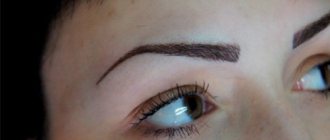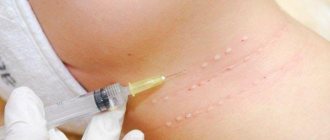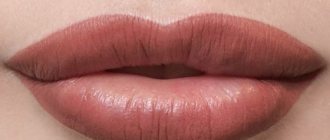Free consultation with a doctor by phone
Surgeon appointments are available daily by appointment!!!
LLC "Your Doctor"
Chat with the doctor
Addresses of medical centers in Moscow (unified reference) +7 (495) 255-45-59
Make an appointment at the clinic Discount on services Promotions
- +7 (495) 255-45-59
- Surgical centers in Moscow
- Every day from 9.00 to 20.00
- call me back
You can make an appointment with our operators by calling +7 (495) 255-45-59
Prices for services Clinic address Make an appointment Call a surgeon to your home Pediatric surgeon Ligation
An abscess after an injection can occur in anyone who has undergone this unpleasant procedure at least once in their life. If intramuscular injection is performed correctly, the risk of developing an abscess is minimal. However, there are situations when a lump may appear at the injection site, which does not dissolve for a long time.
In the worst case, the injection site may become red and inflamed, and pus begins to accumulate in this area, which is surrounded by a capsule. In this case, you should not delay contacting a doctor.
Useful information on the topic:
- Abscess treatment
- Opening an abscess
- Purulent abscess
- Abscess of the buttocks
- Abscess removal
- Abscess in pregnant women
- Bartholin gland abscess
- Abscess in a child
- Finger abscess
- Abscess puncture
- Skin abscess
- Causes of abscess
What symptoms are typical?
An abscess after an injection does not present difficulties for diagnosis in the vast majority of cases. Signs of abscess development may be as follows:
- A few days after the injection, hardening and swelling of the soft tissue appears. On palpation, pain is noted at the injection site. These symptoms may go away spontaneously after a few days. At this stage, it is possible to help the patient with home remedies.
- The pain at the injection site becomes more intense and intensifies when changing body position, trying to sit down, or touching. Sometimes patients complain that the pain penetrates to the bones.
- The skin at the injection site turns red, swells, and becomes hot. There may be an increase in overall body temperature.
- When palpating the injection site, a compaction is detected with a focus of softening and fluctuations in the center.
Timely seeking medical help at our clinic will help cure the unpleasant consequences of the injection. Only a surgeon should treat at the stage of abscess formation.
Useful information about visiting a surgeon at the clinic:
- How to prepare for a surgeon's appointment
- What diseases does the surgeon treat?
- Calling a surgeon to your home
- Surgical care in the clinic
- Surgical care at home
- What symptoms should you contact a surgeon for?
- Treatment of surgical diseases
- Treatment of intestinal pathologies
- Treatment of skin surgical pathologies
- Treatment of bedsores and necrosis
- Treatment of parasitic diseases
- Treatment of inflammatory processes of soft tissues
- Treatment of diseases of the musculoskeletal system
- Diagnosis of surgical diseases
Observation after vaccination
If the lump is small and lasts no longer than 3-5 days, there is nothing to worry about. Many mothers begin to worry when the lump grows or when it does not go away for a long time. But here, first of all, you need to look at the child’s well-being: if there are no noticeable problems, then you should not panic, even if the lump does not resolve for a couple of weeks.
To know exactly what reactions are possible after vaccination, carefully read the instructions for the vaccine. We advise you to follow the following rules after vaccination:
- Do not wet or heat the injection site, it should be dry. Wear clothing to prevent the injection site from sweating.
- When you wash, do not rub the injection site with a washcloth; it is better if soap does not get on it.
- Do not treat the wound with anything, including ointments (for example, Vishnevsky), creams, brilliant green and iodine: by your actions you can turn the body’s normal reaction to a vaccine into an abscess.
- Do not rub or comb the wound, do not crush or put pressure on it, and do not let your child do this.
- You should dress in loose clothing so that the injection site does not rub against the fabric. It is better to choose clothes made from natural fabrics, as synthetics can cause an allergic reaction.
How to relieve the condition
Since the lump is a common local reaction to the vaccine, we strongly advise you not to panic and avoid self-medication: after 3-5 the lump will resolve itself, and the wrong medications can only worsen your health. If your child tries to scratch the injection site, you can cover it with a light gauze bandage.
Reasons for the development of abscesses after an injection
Any intramuscular injection is an invasive procedure. Such an intervention violates the integrity of the skin and triggers a whole chain of pathological changes. As a rule, the cause of an abscess is incorrect administration of injections in violation of the rules of asepsis and antisepsis. Often such complications occur if the injection was given at home.
Predisposing factors for the development of an abscess are decreased immunity and a sharp weakening of the body.
The correct way to administer the injection is to insert a needle into the upper outer quadrant of the buttock. It is permissible to inject the medicine into the muscle layer of the shoulder or thigh. If the syringe needle enters a large blood vessel, hemorrhage occurs into the soft tissue, which can lead to the development of an abscess. A number of drugs can have an irritating effect on tissue; when administered not into the muscle, but into the subcutaneous fat, it can also lead to the formation of an abscess.
If the wound at the injection site was scratched, this could serve as an entry point for infection and cause a suppurative process.
What symptoms do you see a surgeon for:
- Presence of hernial protrusion
- Daggering pains in the abdomen
- Bloating
- Pain in the right hypochondrium
- Bitterness in the mouth
- Nausea
- Presence of neoplasms on the skin
- Swelling and redness of the skin
- Bone fractures and bruises
- Wounds of any location
- Vomit
- Enlarged and painful lymph nodes
Quincke's edema is not fatal
Angioedema, Quincke's edema, anaphylactic shock... We know that all these are acute conditions associated with allergies, but most of us do not particularly understand the difference between them, and do not understand how to help ourselves or another person in such a situation. We asked a professional to clarify
Our questions are answered by
Doctor of Medical Sciences, Professor of the Department of Childhood Diseases of the Children's Children's Diseases named after N.F.
Filatov Sechenov University, allergist-immunologist of the highest category Asya Kudryavtseva. – Asya Valerievna, let’s start with Quincke’s edema, which is especially often discussed on social networks. How dangerous is this condition?
– Quincke's edema is an outdated name. Now it is called angioedema.
Angioedema and urticaria are two parallel ongoing stories. These are conditions associated with the release of histamine from mast cells.
Histamine
An organic compound with a number of functions, including being a mediator of immediate allergic reactions. Under normal conditions, histamine is found in the body predominantly in a bound, inactive state. During various pathological processes, as well as when certain chemicals enter the body, the amount of free histamine increases.
- How does this happen?
– In case of allergies, angioedema can be caused by taking medications, food products, in young children after eating milk or eggs, in older ones - fish, seafood, nuts or peanuts. Swelling can occur when bitten by stinging insects.
Immunoglobulins E are antibodies directed against a protein we call an allergen and are associated with immediate, dangerous allergic reactions. Allergens dock with immunoglobulin E, like spaceships dock with a station, and together they attach to mast cells, which release histamine in response. Histamine, in turn, enters the body tissues, causing symptoms such as redness, swelling and itching.
If the release of histamine occurs on the skin of the arms, abdomen and back, blisters will appear in these places, such as we see when a mosquito bites. With urticaria, the blisters can be small in diameter, but sometimes they increase in size and even merge.
Angioedema, unlike urticaria, is the release of histamine in that part of the skin where it is well supplied with blood and is prone to swelling. If this occurs in the area of the eyelids, lips, hands or feet, the swelling in a person looks threatening, and it often changes his appearance. Despite the fact that the symptoms of urticaria and angioedema are not very similar, the essence of the events that occur is the same.
– Doesn’t angioedema affect the larynx? After all, this is the scenario that people fear most.
– It seems to us that with swelling of the eyelids and lips, a similar process occurs in the larynx. In fact, this is not true. Laryngeal edema is an extremely rare condition.
I have encountered the following misunderstanding: some people believe that angioedema is the lips and eyes, but Quincke's edema is the swelling of the tongue and larynx. In fact, angioedema and angioedema are different names for the same condition.
Just Quincke's edema, as I already said, is an old terminology that has existed since the end of the 19th century, when the German physician Heinrich Quincke first described it.
But now it has fallen out of use in professional language. The fact is that when we see blisters on the stomach, it does not particularly frighten us, but when a child or an adult’s eyelids are so swollen that it is difficult to open their eyes, the lips have greatly increased in size, there is a feeling that something completely terrible is happening, and we begin to fear serious consequences.
I have discussed angioedema many times with resuscitators, asking them how often angioedema actually leads to respiratory arrest. They answer that they have not encountered fatal outcomes of angioedema when it comes to allergic conditions associated with histamine.
– Where does the fear of death from suffocation due to angioedema come from?
– There is a very dangerous disease - hereditary angioedema (HAE), which, indeed, can lead to fatal consequences, but, despite its external resemblance to ordinary angioedema, it is a completely different independent disease, and an orphan (very rare). It is not caused by an allergy.
If with ordinary angioedema antihistamines help well, then with HAE the lips and tongue may swell, greatly increasing in size, but no antiallergic drugs will help here. The leading role here belongs not to histamine, but to bradykinin, a completely different mediator.
This condition also occurs suddenly, but rarely in children, more often in adults, and it can be provoked by a sudden strong experience or stress.
Not only antihistamines will not relieve such angioedema, but also hormonal drugs that are used for severe allergic reactions; only a blood plasma transfusion or the introduction of special medications that are not available over the counter will help.
Doctors know how to differentiate between these two conditions, but lay people are usually unaware of the difference between the two diseases, and are worried that they may suddenly have an attack that will lead to respiratory arrest.
It turns out that fears of a fatal outcome are true only in relation to hereditary angioedema, in which the tongue can swell to such an extent that suffocation occurs. I repeat once again: this condition is very rare, there are only a few such patients.
As a rule, before this kind of attack occurs, the patient already knows about his illness. It is possible that he has already been on the operating table due to sudden abdominal pain characteristic of appendicitis. They begin to operate on him for appendicitis, but they find swollen mesentery and intestines there, because swelling in such patients can occur in any part of the body.
Simple angioedema can be treated with all the familiar antihistamines and hormones.
– Can allergic angioedema suddenly appear in adulthood?
– Yes, this happens, but unlike HAE, it is precisely an allergic reaction. In adults it is most often a drug allergy, in children it is a food allergy. These conditions, as I have already mentioned, depend on the appearance of class E immunoglobulins in the blood, the level of which can be looked at in the blood after an attack and the allergy can be confirmed.
This situation is not fatal, and the person can be helped.
Angioedema occurs within a few minutes to two hours after contact with the allergen. With an allergy to animals, it can develop in a child, for example, if his hands are licked by a dog as a reaction to the animal’s saliva. Or, for example, if a child stroked an animal and then rubbed his eyes with the same hand. There will also be swelling there. Then we will talk about allergens that are in the fur of a cat or dog.
When plants bloom, pollen can get into your eyes and cause swelling of the eyelids. This year, the alder bloomed for a very long time and intensively, and we, allergists, observed angioedema of the eyes quite often. This is always an acute immune-dependent reaction, that is, a manifestation of pollen allergy (hay fever).
– What would you recommend as first aid?
– Absolutely all people prone to developing allergies should have some kind of antihistamine in their home or travel medicine cabinet, since, indeed, the onset of allergies can happen suddenly.
A child or adult with angioedema must be given a drug that blocks the effect of histamine on tissue. I would like to note that often there is no high urgency in taking a medicine, and if suddenly such a drug is not at hand, you can have time to get to the nearest pharmacy and buy it. They are freely available.
In the acute phase of the disease, absolutely any antihistamines can be used, including those that cause a sedative effect (suprastin or tavegil). These drugs are absorbed already in the oral cavity, act as quickly as possible and relieve swelling well.
It must be remembered that after taking such a drug, a person should not drive. Most likely, the doctor will prescribe further treatment for him, and then he will need to use a more modern medicine (Claritin, Erius, Zyrtec or Xyzal), which is taken once a day and does not have a sleeping effect.
These drugs retain high concentrations in the blood well, so their effect, unlike first-generation drugs, is quite long-lasting. They are not addictive, so you can take them for a long time.
– And there is also anaphylaxis. Should I be afraid of her?
– Anaphylaxis is a lesion during the development of an allergy of at least two systems at once. In the vast majority of cases, this happens to a person who has been suffering from allergies for some time. This is a condition that affects more than just the skin. Other organs are involved, and we observe, for example, angioedema and difficulty breathing, angioedema and diarrhea, hives and vomiting, and so on.
In itself, anaphylaxis without shock is not a life-threatening condition, but it is anaphylactic shock, which is quite rare, that leads to the death of the patient.
Due to increased anxiety these days, many people mistakenly believe that anaphylactic shock can suddenly happen to literally anyone, which is absolutely wrong.
This is a very rare occurrence even in people who suffer from allergies, let alone in the healthy population.
It happens like this.
A child or adult ate peanuts for the first time and his mouth itched. The second time, swelling of the eyes occurred. The third time, not only did my eyes swell, but it became difficult to breathe. When swelling of the eyes and suffocation occurs, this is already an anaphylactic reaction. It can be either not very severe or severe, when loss of consciousness occurs and the person may die.
A reaction is considered mild when there is no sharp decrease in pressure and changes in the cardiovascular system. Doctors treat this condition with a fast-acting drug called epinephrine.
In everyday life in developed countries of the world, auto-injectors are used - these are syringes in the form of automatic pens so that the patient, feeling the approach of anaphylaxis, can quickly inject himself (or a sick child) into the thigh directly through clothing. This should be done when even mild anaphylaxis occurs, without waiting for shock.
Usually a person knows how his allergies develop. It is clear to him from the symptoms that he ate something wrong, for example, there were trace amounts of peanuts in chocolate without nuts, which is an allergen for this patient.
Epipen - the so-called pen filled with adrenaline, can be used in absolutely any situation, not necessarily at home or in a hospital. It is recommended that each patient always have two of these pens with him.
In Russia, Epipen and Epipen Junior (for children) are registered, but, unfortunately, they are not sold in pharmacies.
Anyone who is at risk of developing anaphylaxis needs to be trained in how to give injections with a regular syringe at home or with an auto-injector while an ambulance is being called for the patient. Administering adrenaline by regular injection is not a very good treatment option, because it is not so easy to calculate and inject the required dose of adrenaline.
Now such patients and parents of children prone to anaphylaxis are uniting among themselves to achieve centralized purchase of Epipen from the state so that it can be purchased at a pharmacy with a doctor’s prescription. However, many of them buy EpiPen online, which is not prohibited by law.
To teach how to use an auto-injector, the manufacturing company even produces special training pens. The patient should be trained not to worry about how he will cope with the injection in an acute situation. They also explain to him what sensations he should experience during autoinjection.
It must be borne in mind that even after the administration of Epipen, it is necessary to call an ambulance, and doctors must monitor the condition of the child or adult after an attack of anaphylaxis.
Often, parents of children at risk of developing anaphylaxis themselves use the drug prednisolone. In such cases, we doctors instruct them in detail.
I would like to emphasize once again: anaphylaxis is a rare phenomenon, and anaphylactic shock is even rarer. I observe a level of anxiety among people about these phenomena that is completely out of proportion to the scale of the problem.
For example, many people believe that dental anesthesia drugs are extremely dangerous, and literally each of us has a chance of not getting out of the chair after dental treatment.
There are studies, however, that demonstrate that the risk of anaphylaxis due to local anesthetics is extremely low. It happens that a person attributes the symptoms that he experiences after such an injection to anaphylaxis, but in fact he had them as a result of a panic attack.
I write a blog, “Life Without Allergies,” on the Internet. There I provide scientific data, for example, the following: the number of deaths from anaphylaxis is from 0.35 to 1.06 episodes per million inhabitants per year, while this figure has not changed over the past 10-15 years. Moreover, death from anaphylaxis in the general European population is much less common than accidental death.
Cases of death from anaphylaxis are often described in the media, which is why they cause such a strong reaction in us. Now people are more worried about their health than usual, but I advise everyone to approach the problem wisely and not be afraid of an event whose risk for the vast majority of people is negligible.
Link to publication: miloserdie.ru
How to treat an abscess
The abscess is removed by a surgeon. If you do not seek medical help in a timely manner, this can lead to even more serious consequences for the patient.
- If the inflammatory process is infiltrative and non-purulent, conservative treatment is used. Physiotherapy, absorbable medications, and warm compresses are prescribed. It is recommended to lubricate the injection site with an alcohol solution of iodine.
- If pus begins to form at the site of inflammation, the doctor at our clinic will perform a puncture, remove the accumulated pus and rinse the cavity.
- If the abscess is deep, surgical treatment is performed. An incision is made at the site of the abscess, the cavity is washed and drained.
- In case of an extensive process and symptoms of general intoxication, treatment with antibiotics, immunomodulators, and vitamins is prescribed.
Qualified specialists at our clinic treat purulent inflammatory diseases using the most effective and safe methods and medications.
Diagnostic methods in surgery:
- Doppler in surgery
- Colonoscopy
- Angiography
- CT scan
- Gastroscopy
- MRI
- Abdominal ultrasound
- X-ray
- Endoscopy
Prices:
| Code | Name of service | Prices |
| 1 | Initial appointment | 1200 |
| 2 | Repeated appointment | 900 |
| 3 | Calling a surgeon to your home | 3500 |
| 4 | Abdominal ultrasound | 2200 |
| 5 | Ultrasound of veins and vessels | 2400 |
| 6 | Doppler 2-3 trimester | 1200 |
| 7 | Rectoscopy | 1500 |
Tips and tricks
To know more or less accurately what local reactions are possible, carefully study the instructions for the drug: it is not always possible to find detailed descriptions of reactions there, but the main ones should be written about.
If your hand hurts too much, interferes with sleep or distracts you from work, you can take painkillers - Paracetamol and Ibuprofen. As for the use of ointments or other external influences on the injection site to relieve pain, there are as many doctors as there are so many opinions: some are categorically against it, while others, for example, advise applying a clean wet cloth. It is better to look at the instructions and consult a doctor before vaccination.
After vaccination, try to follow these simple rules:
- As a preventive measure, immediately after the injection, press the injection site with a cotton swab for 2-3 minutes.
- The injection site should remain dry; it is better not to wet it or heat it.
- Wear well-ventilated, loose-fitting clothing to prevent the injection site from sweating or rubbing against the fabric.
- When you wash, do not rub the injection site with a washcloth; try not to get soap on it.
- Do not treat the wound with ointments, creams, brilliant green or iodine: you can turn the body’s normal reaction to the vaccine into an abscess.
- Do not scratch the injection site.
How to remove the Tyndall effect
If a filler based on hyaluronic acid was used, it needs to be absorbed. Most often, hyaluronic injections are used, so to eliminate the consequences, an injection of an enzyme preparation, hyaluronidase, is used.
This substance breaks down excess hyaluronic acid (in the case of the Tyndall effect, it fights excess filler) into simple elements, for example, water. Water is removed from the body naturally, and the swelling goes away within 6 hours after the injection, in especially severe cases - within 72 hours.
It is best to get rid of unsuccessful consequences in the same salon where the first procedure was done. The cosmetologist knows what drug was used and how deeply the substance was injected. But if you doubt the doctor’s professionalism, it is better to look for a competent specialist in another clinic. Pay attention to reviews before visiting a cosmetologist's office.
Find out which method of correcting scars and stretch marks is optimal for you!
doctor Svetlana Viktorovna Ogorodnikova.
doctor
It is also important to accurately calculate the location and amount of hyaluronidase, because it can remove all the filler - then the beauty injection will have no effect at all. Many cosmetologists believe that poor-quality work should be removed entirely, so be prepared to repeat the filler injection, but not earlier than 2 weeks after hyaluronidase.










